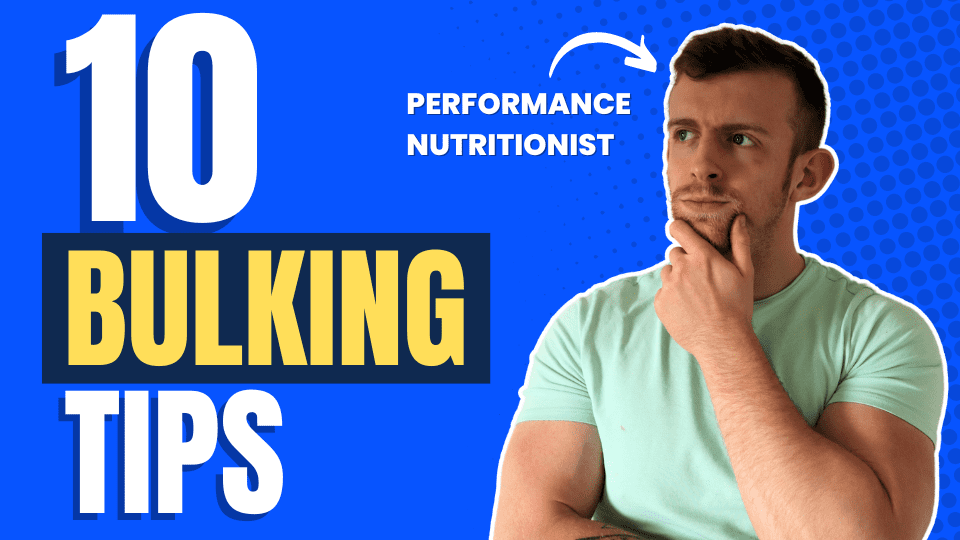We coach a lot of people, helping them to get bigger stronger and to build muscle, and in this article, we are going to discuss 10 muscle-building diet tips we very frequently utilise with those muscle-gain clients.
One of the biggest issues that you’re going to experience with trying to gain muscle, is struggling to consume enough calories consistently. As you will know from our content on how to set up your diet and from your understanding of calories, your calorie intake is the thing that’s going to drive the adaptations and performance that result in new muscle tissue. If you want to get bigger, you are going to have to find ways to increase your calorie intake, and that is where the following muscle-building diet tips fit in!
10 Muscle-Building Diet Tips
Space Your Meals Out
First on the list is spacing your meals out throughout the day. By spacing your meals evenly throughout the day, you’re giving yourself the best chance to hit your calorie target, rather than leaving everything towards the evening and forcing yourself into a position where you have to get a lot of calories in that three or four-hour window before you go to bed. The combination that people experience here is that they have to resort to high-calorie junk food, which leaves them feeling a little bit bloated and might potentially disrupt their sleep. So, if you’re only eating two or three times per day, eat four or five times per day. Space those meals and snacks out a little bit more and try to get a few more calories in the earlier part of the day as well.
Consume Liquid Calories
Number two on the list is liquid calories. When you’re dieting for fat loss, you want to avoid liquid calories at all costs because they don’t provide much satiation. But when you’re bulking, the opposite is often what we’re trying to achieve. So, we’re really trying to take advantage of the low satiety-to-calorie ratio that you get with liquid calories. Some good examples here include whole milk, chocolate milk, sports drinks, fruit juices, and smoothies. You can easily add an extra two, three, or four hundred calories to each one of your meals if you had one of these drinks along with that meal.
Consume Low Volume Carbohydrates
Number three is choosing carbs that are lower in volume and easier to digest. Good sources here include jasmine rice, orzo, cereal, white bread, and rice pudding. These are easier to eat and won’t fill you up as much as foods like potatoes, quinoa, and brown rice.
Consume Higher Fat
Next, we want to use higher amounts of fats to try and hit our calorie goals a little bit easier. With fat being the most calorie-dense of the three primary macronutrients at nine calories per gram, it makes sense to use plenty of fat in the day whenever we’re trying to hit our calories for bulking. So, make sure to use olive oil when you’re cooking or as a dressing over certain foods. Use nut butter in some of your meals, eat some more dark chocolate, use a little bit of cream in your smoothies, and make sure that you’re snacking on nuts throughout the day as well.
Consider Lowering Your Protein
Number five is to potentially consider lowering your protein intake. Now, one of the problems that I see in my coaching practice is people trying to bulk with a super high protein intake. Now, this isn’t a problem in and of itself, but protein is pretty satiating. So, if you’re struggling to get those calories in, you might be shooting yourself in the foot by trying to maintain a very high protein intake. You can safely go to the lower end of the protein range, about 1.6 to 1.8 grams of protein per kg of body weight, because being in a calorie surplus is anabolic in and of itself, and it’s totally fine to have a slightly lower protein intake in this context.
Use High-Calorie Sauces
Number six is to use higher-calorie sauces and dips. This is a fairly easy one because you’re probably using some level of sauces in your meals already, and you just need to make a simple swap to one food or another, and this can easily increase your calories. Some good examples here include carbonara or cheesy sauces for pasta, sweet chilli sauce, guacamole, hummus, and mayonnaise.
Consume High-Calorie Proteins
Number seven is to try and use higher-calorie proteins. Similar to my point earlier about using higher fats in the diet, you can also increase your fat intake by using some of these fattier protein sources. Some examples here include fatty mince, fatty cuts of steak like ribeye, salmon, mackerel, pork, lamb, chicken thighs with the skin on, breaded or buttered meats and fish, eggs, and certain soy substitutes which use higher amounts of fat in the production process.
Eat Dessert!
Number eight on the list is one that’s usually very well received by a lot of my clients that are in a bulking phase, and that is to add desserts to some of your meals. Now, while we still want to eat mostly healthy food when we’re bulking, if you’re really struggling to get the calories in and your diet is mostly healthy and varied, then it’s not a problem to use some of these higher-calorie desserts and sweet foods. Some good examples here that my clients like include Nutella on a little bit of toast, some biscuits, ice cream, custard, or rice pudding.
Jar of Nuts
Number nine on the list is to have a jar in your house that is filled with nuts, dried fruit, and trail mix. Because nuts, dried fruit, and trail mix are quite calorie-dense, this is a really good way of just upping your calories and interspersing these little, one to two-hundred-calorie bombs throughout the day.
Use Intra-Workout Carbohydrates
Number ten, the last one, is to consider using an intra-workout carbohydrate supplement. While there’s probably not that much benefit to intra-workout carbohydrate supplementation during your resistance training workouts, it is an easy way of getting extra carbs into the diet and thus hitting your calorie goals. And if your workouts are particularly long or you do multiple sports at the same time, this can provide an additional performance benefit as well.
Muscle-Building Diet Tips Summary
Hopefully, these muscle-building diet tips give you some ideas about how you can get some more calories in the diet. When you are trying to put on muscle, it is important to find ways to actually get sufficient nutrients in, as your appetite is going to work against you as you get deeper into a gaining phase. These tips have been incredibly effective in helping our clients gain muscle effectively. If you think you need more specific help with your own diet, then online coaching may be for you. If you just want to go it alone, then we do recommend you learn how to set up your diet correctly. We also coach people to become nutrition coaches, if that is something you are interested in. Finally, you can stay up to date with our video content by subscribing to our YouTube channel.

